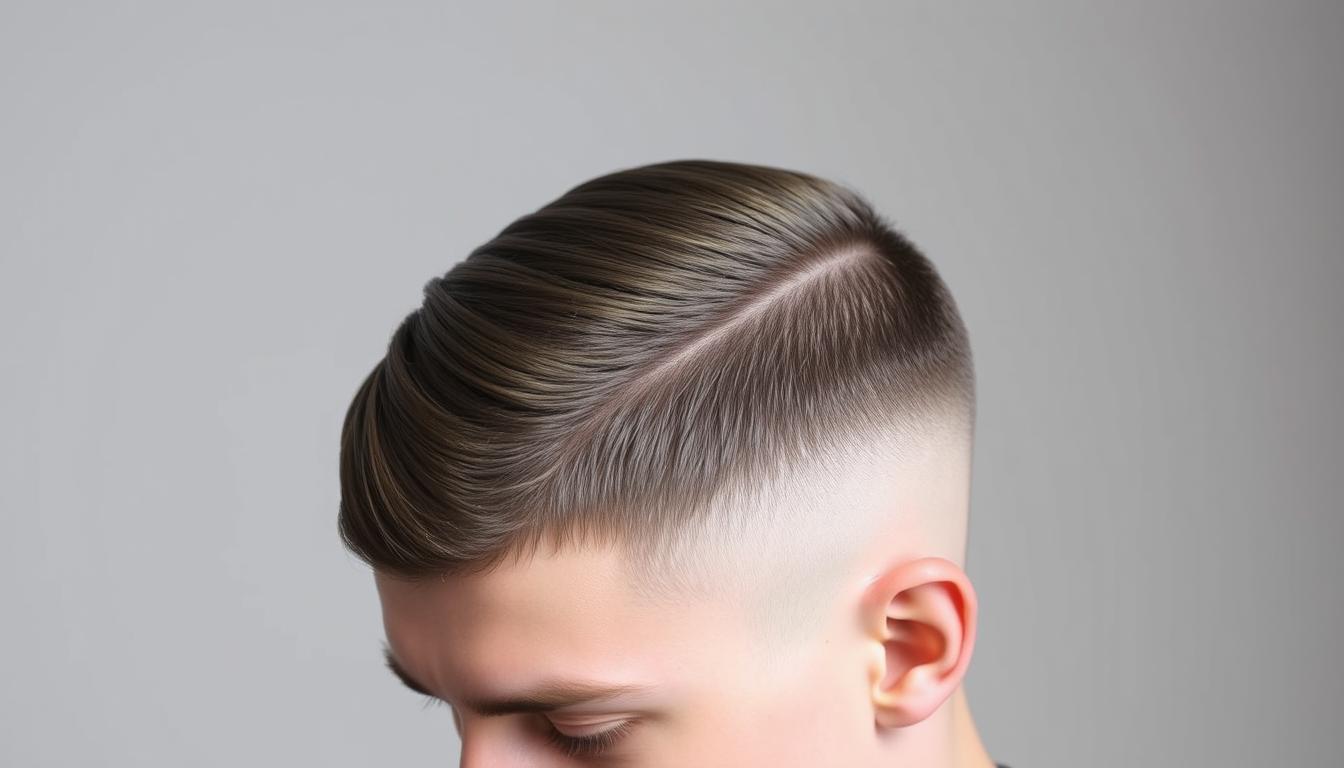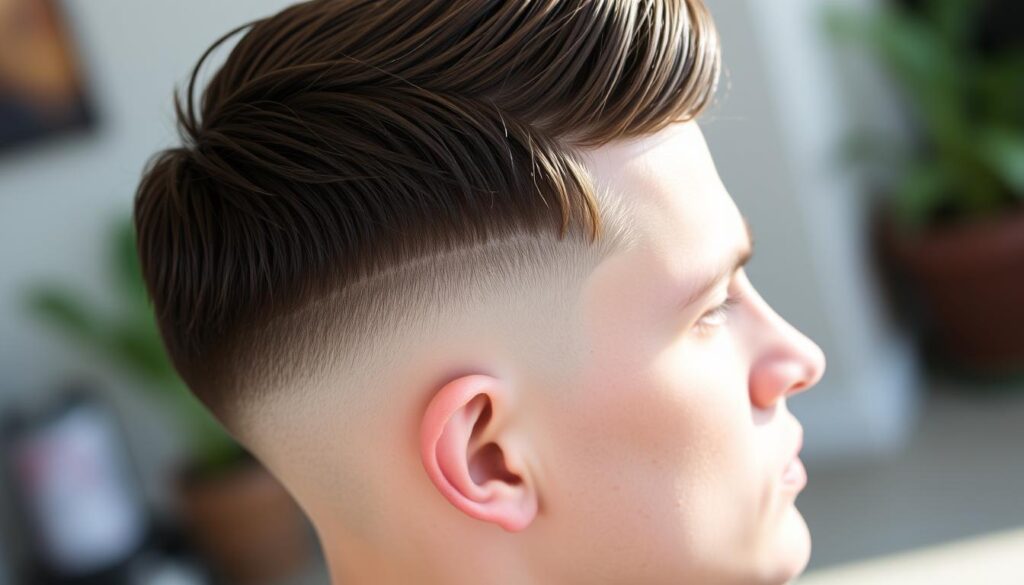
What if one haircut could elevate your style for every occasion—from boardrooms to weekend adventures? The answer lies in a sharp, adaptable design that masters balance between boldness and subtlety. This isn’t just another trend; it’s a refined aesthetic that adapts to your life while keeping you polished.
Imagine a trim where the sides blend seamlessly into the skin, creating a clean foundation for textured hair on top. This approach works whether you prefer a crisp professional appearance or a relaxed vibe. The magic comes from its tapered transition, which adds dimension without overwhelming your natural features.
But what makes it stand out? Unlike bulkier styles, this cut emphasizes precision. A skilled barber ensures the gradual fade starts lower near the ears, maintaining enough length to frame your face. The result? A look that’s both timeless and fresh—ideal for men who want versatility without sacrificing sophistication.
Key Takeaways
- Versatile for casual and formal settings
- Subtle tapered sides enhance facial structure
- Works with various hair types and lengths
- Requires precision cutting for seamless blending
- Easy to maintain with minimal styling effort
Understanding the Crew Cut Low Fade

Why do some styles stay relevant decade after decade? The answer lies in smart design that adapts without losing its core identity. This approach defines the modern take on a military-inspired classic, blending sharp angles with soft transitions.
Definition and Key Features
This style keeps 1-2 inches of texture up top while tapering downward. The gradual shortening begins near the ear line, creating shadow-like depth. Unlike uniform buzz cuts, it preserves enough length to style the crown area with product or natural movement.
| Feature | Crew Cut Low Fade | Buzz Cut |
|---|---|---|
| Top Length | 1-2 inches | Uniform ¼ inch |
| Fade Start Point | Above ears | None |
| Maintenance | Every 3-4 weeks | Every 2 weeks |
Historical Background
Originally designed for soldiers in the 1940s, this cut prioritized practicality. Barbers later refined it by adding gradual tapering techniques from urban barbershops. Today’s version balances its rugged roots with contemporary precision tools for smoother blends.
Modern iterations work for both corporate environments and casual outings. The secret? Strategic contrast that highlights facial structure without extreme length differences. It’s become a go-to for men wanting polish without daily styling hassles.
The Evolution of Men’s Crew Cut Hairstyles

How did a functional haircut become a style icon? Its journey began on Ivy League rowing teams in the early 1900s. Athletes needed trims that stayed put during races—no flapping locks blocking their vision. This practical need birthed the term we recognize today.
From Military Origins to Modern Trends
When the U.S. Army adopted this look in the 1930s, it spread faster than bootcamp rumors. Soldiers loved its no-nonsense maintenance, while civilians admired its crisp, disciplined appearance. Post-World War II, it symbolized the clean-cut American ideal—think James Dean meets Dwight Eisenhower.
The 21st century reinvented this classic. Barbering innovations introduced textured tops and gradient fades, blending tradition with fresh flair. Today’s versions work for CEOs and skateboarders alike, proving adaptability is key to longevity.
- 1900s: Born from athletic necessity
- 1930s-40s: Military adoption boosts popularity
- 1950s: Becomes cultural shorthand for reliability
- 2000s: Modern techniques add dimension and edge
You’ll notice contemporary versions keep the original’s spirit—easy upkeep, face-flattering shapes—while embracing personalization. Whether paired with a beard or clean-shaven, this design remains a chameleon in men’s grooming.
Exploring Classic and Modern Variations
Confusion between hairstyle terms can lead to unexpected results at the barber’s chair. While some designs share similarities, their execution and impact differ dramatically. Let’s clarify the distinctions and explore how modern twists keep this style relevant.
Classic Crew Cut vs. Buzz Cut
Many assume these trims are identical, but the devil’s in the details. A buzz cut removes nearly all length, leaving a uniform shadow-like finish. In contrast, the classic version preserves 1-2 inches up top for texture and movement.
| Feature | Classic Crew | Buzz Cut |
|---|---|---|
| Top Length | 1-2 inches | ¼ inch or less |
| Sides | Tapered graduation | Uniform length |
| Styling Options | Textured or slicked | None |
| Maintenance Cycle | 3-4 weeks | 2 weeks |
Long Crew Cut and Crew Cut Comb Over
Modern variations expand styling potential. The long crew extends the crown area to two inches, allowing tousled finishes or polished sweeps. For formal settings, the comb-over version adds a defined side part, creating sharp angles that frame the face.
“The comb-over adaptation proves that traditional designs can adapt to contemporary trends without losing their identity.”
These updates maintain tapered sides while offering more expressive freedom. Whether you prefer matte texture for casual outings or a sleek finish for meetings, the variations work across scenarios. The key lies in balancing top length with gradual fading for structure.
Crew Cut Low Fade: Timeless Men’s Hairstyle
Hollywood’s leading men know a secret: the right trim bridges rugged charm and boardroom-ready polish. This design’s subtle gradient creates depth while keeping proportions balanced—a trick that works whether you’re pitching clients or hitting the gym.
What Sets It Apart
Unlike dramatic fades that scream for attention, this version whispers sophistication. The transition begins just above the ear line, maintaining enough length to soften jawlines without losing definition. It’s like a tailored suit—structured yet adaptable to your body’s contours.
Celebrities favor it because it complements every setting. David Beckham pairs it with stubble for urban edge, while Ryan Reynolds keeps it crisp for red carpets. The magic lies in its customizable contrast—barbers adjust the blend to match your hair density and face shape.
“A well-executed low fade acts like natural contouring, enhancing bone structure without looking overdone.”
Why does it endure? Three reasons:
- Professional flexibility: Works under a hard hat or a fedora
- Low maintenance: Grows out gracefully between trims
- Universal appeal: Flatters oval, square, and round faces equally
This approach eliminates the “fresh cut” urgency. You gain 4-5 weeks before needing a touch-up, saving time and money. It’s the Goldilocks of men’s grooming—not too bold, not too bland, but just right.
The Art of Fading: Low Taper, Skin, and Burst Fades
Not all fades are created equal. The magic lies in how sharply or softly hair transitions from longer lengths to shorter ones. Three techniques dominate modern barbering—each creating distinct effects that shape your overall look.
Understanding the Fade Types
The low taper fade acts like a gentle whisper. It starts above your ears, leaving subtle length at the neckline. Perfect for office settings, it maintains professionalism while adding dimension. Maintenance? Just a trim every 4 weeks.
Craving drama? The low skin fade shaves sides and back to the scalp. This bold contrast makes textured tops pop like exclamation points. Barbers recommend touch-ups every 2-3 weeks to keep lines crisp.
For those wanting flair, the low burst fade curves around your ears and crown. Imagine sunlight radiating from your temples—this circular pattern pairs perfectly with messy quiffs or slicked-back styles. It’s artistry meets anatomy.
| Feature | Taper Fade | Skin Fade | Burst Fade |
|---|---|---|---|
| Contrast Level | Subtle | High | Dynamic |
| Maintenance | 4 weeks | 2-3 weeks | 3 weeks |
| Best For | Professional looks | Bold statements | Creative styles |
“Choosing the right fade is like tailoring a suit—it should complement your lifestyle while highlighting your best features.”
Your hair’s texture and face shape determine which fade works best. Thick curls? A skin fade reduces bulk. Straight hair? A burst fade adds movement. The goal: balance sharpness with wearability.
Benefits of Choosing a Crew Cut Low Fade
Ever wished for a haircut that works as hard as you do? This design delivers all-day readiness without demanding constant attention. Its smart structure keeps you looking sharp from dawn meetings to late-night socials.
Practicality for Daily Life
Morning routines shrink to two minutes. A quick towel-dry and light product give your textured top natural movement. The tapered sides stay neat for weeks, growing out evenly without awkward bulk.
You’ll save both time and money. Unlike high-maintenance trims, this style keeps its shape through workouts, rain, or helmet use. Barbers recommend touch-ups every 4-5 weeks—perfect for busy schedules.
Versatility in Styling
Transform your look without scissors. Use matte paste for casual texture or sleek pomade for formal events. The 1-2 inch crown length adapts to side parts, messy spikes, or brushed-back finishes.
Pair it with stubble for rugged charm or keep faces clean-shaven for corporate polish. This cut enhances jawlines on round faces and softens angles on square shapes. It’s your canvas—paint it differently each day.
“A great haircut should empower your lifestyle, not complicate it.”
Whether you’re presenting to clients or hiking trails, this design maintains professional polish while letting personality shine. The secret? Strategic contrast that frames features without shouting for attention.
Styling Techniques for a Perfect Crew Cut
Mastering your look starts with the right products and techniques. Begin with a dime-sized amount of matte paste rubbed between palms. Work through damp hair from roots to ends, lifting strands upward for instant texture. This creates natural movement that lasts all day without stiffness.
For formal events, swap matte products for light-hold pomade. Use a fine-tooth comb to create clean side parts or sleek sweeps. The textured top adapts effortlessly—tousle it with fingers for casual outings or smooth it back for meetings.
Maintain your style between trims with dry shampoo. A quick spritz absorbs oil at the crown while adding volume. Always blow-dry hair upward after washing to enhance its natural lift.
The secret lies in balancing structure with adaptability. Let your tapered sides grow out slightly for a relaxed vibe, or keep them crisp for sharp contrast. Pair with beard oil if maintaining facial hair to unify your grooming aesthetic.
Book a barber consultation every 4 weeks to refine proportions. Bring photos showing front/side views to communicate length preferences clearly. This ensures your cut always complements your facial structure while staying true to personal style.
